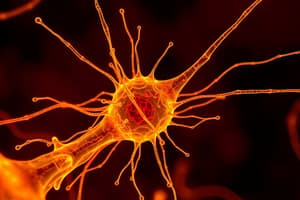Podcast
Questions and Answers
What is the primary function of filamentous actin in the cell?
What is the primary function of filamentous actin in the cell?
- Providing structural support (correct)
- Facilitating cellular communication
- Transporting nutrients within the cell
- Storing genetic information
Which of the following statements accurately describes cytoskeletal elements?
Which of the following statements accurately describes cytoskeletal elements?
- They are static structures that do not change.
- They only function in cell division.
- They are composed solely of lipids.
- They play a role in both cell movement and organization. (correct)
What role do cellular junctions primarily play in tissues?
What role do cellular junctions primarily play in tissues?
- They facilitate the anchoring of cells to the extracellular matrix. (correct)
- They synthesize proteins for the cell.
- They act as barriers to prevent cellular communication.
- They are responsible for ATP production.
Globular actin is the monomeric form of which cytoskeletal structure?
Globular actin is the monomeric form of which cytoskeletal structure?
Which type of cellular junction is primarily responsible for strong adhesion between cells?
Which type of cellular junction is primarily responsible for strong adhesion between cells?
Flashcards
Filamentous actin function
Filamentous actin function
Provides structural support to the cell.
Cytoskeletal elements role
Cytoskeletal elements role
Support cell movement and organization.
Cellular junctions and tissue
Cellular junctions and tissue
Anchor cells to the extracellular matrix.
Globular actin and filamentous actin
Globular actin and filamentous actin
Signup and view all the flashcards
Desmosomes role
Desmosomes role
Signup and view all the flashcards
Study Notes
Cytoskeletal Filaments
- Actin filaments, also known as filamentous actin (F-actin), are crucial components of the cytoskeleton, providing structural support and shape to the cell.
- Globular actin (G-actin) is the monomer that polymerizes to form F-actin, playing a key role in motility and cell division.
- Cytoskeletal filaments are essential for intracellular transport, muscle contraction, and maintaining cell integrity.
Functions of Cytoskeletal Filaments
- Serve as tracks for the movement of organelles and vesicles within cells.
- Provide mechanical support and determine the shape of the cell.
- Facilitate cell division by forming the contractile ring during cytokinesis.
- Participate in signal transduction pathways and cellular communication.
Cell Junctions
- Cellular junctions connect adjacent cells, enabling coordination and communication.
- Types of junctions include tight junctions (prevent leakage between cells), adherens junctions (cell-cell adhesion), gap junctions (allow passage of ions and small molecules), and desmosomes (provide strength).
- Junctions play a vital role in tissue integrity and function, impacting processes such as permeability and electrical coupling.
Summary
- Understanding cytoskeletal elements and junctions is essential for comprehending cellular architecture and function.
- Knowledge of these structures aids in the study of various biological processes and pathologies.
Studying That Suits You
Use AI to generate personalized quizzes and flashcards to suit your learning preferences.




